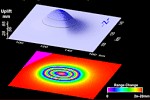Monitoring: | Gas | Ground Deformation | Hydrologic | Remote Sensing | Seismicity |
![]()
![]()
![]()
![]()
Monitoring: | Gas
| Ground
Deformation
| Hydrologic
| Remote
Sensing
| Seismicity |
![]()
Volcanoes change shape before and during eruptions |
|
 Photographs by D.A. Swanson in August
1982
Learn more about thrust faults at Mount St. Helens |
When a series of small ground cracks appeared on the crater floor of Mount St. Helens, scientists spray-painted a straight orange line about 1 m long across the cracks. About two days later, the cracks moved and "bent" the line. The crater floor was deformed or changed shape along thrust faults as magma forced its way up the conduit. Within a few days, the rising magma erupted onto the surface of the volcano's lava dome. |
|
The surface of a volcano often changes shape when magma moves beneath it or rises into its cone. Hundreds of shallow cracks or deep faults tens to hundreds of meters long may develop in hours or days. The ground can change shape by rising up, subsiding, tilting, or forming bulges that are clearly visible to people familiar with the volcano. We use a variety of methods to monitor a volcano's changing shape or deformation. Some methods are as simple as using a steel tape to measure a widening ground crack. Most volcano deformation, however, can only be detected and measured with precise surveying techniques, sensitive instruments placed on the ground or in deep holes, and satellite-based technology. Whatever the method, our goal is the same: determine the changes occurring at a volcano that help us provide eruption warnings and to understand how volcanoes work. |
Upward pressure from
rising magma deforms volcano  Illustration by
B. Myers and S. Brantley |
|
One of the most dramatic examples of ground deformation on a volcano occurred before the eruption of Mount St. Helens in 1980. The volcano's north flank grew outward more than 100 m between late March and 18 May 1980 to form an enormous bulge. The way that scientists monitored the bulge is well illustrated and described in a day by day account of this pre-eruption period. |
|
|
Methods for
Monitoring Volcano Ground Deformation
|
| Electronic Distance Measurements (summary) |
 EDM at Kilauea Volcano |
Measuring the distance between benchmarks placed on a volcano tens to thousands of meters apart with electronic distance meters. |
| Tiltmeters (summary) |
 Installing tiltmeter |
Measuring tiny changes in the slope angle or "tilt" of the ground with tiltmeters is one of the oldest methods for monitoring volcano deformation. |
| Global Positioning System (summary) |
 Augustine Volcano |
The Global Positioning System (GPS) can pinpoint horizontal and vertical movement of the ground in real time and during surveys. |
| Satellite Radar Inferometry (summary) |
 Interferogram showing uplift |
Comparison of radar-generated images from satellites recorded months to years apart can reveal deformation patterns over a broad area with remarkable clarity. |
| Home |
U.S. volcano activity | World volcano activity |
Photo glossary |
Highlights |
| Search this site |
Site index |
Volcano observatories |
Educator's page |